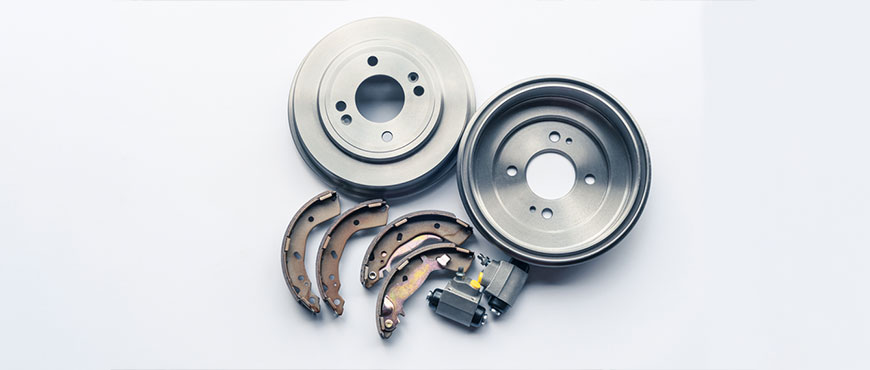
When it comes to braking, every second counts. Whether you’re cruising on the highway or stuck in traffic, your car’s ability to stop instantly can be the difference between safety and disaster. That’s where the debate of Drum Brakes vs Disc Brakes becomes important.
Both systems have shaped modern driving in different ways. Drum brakes reflect mechanical simplicity and endurance, while disc brakes bring precision and control to the table. But which one truly keeps you safer on the road? Let’s take a closer look and uncover the real-world differences every car owner should know.

Drum assemblies have been around for decades and still appear in many vehicles, especially on the rear wheels.
Inside the wheel sits a round metal housing. When you press the pedal, hydraulic pressure forces curved shoes outward against the inner surface of the drum. The friction between the shoes and the rotating cylinder slows the wheel until the car stops.
This enclosed design is durable and less exposed to dust or debris. Because it’s simple and cost-effective to manufacture, you’ll find this system in smaller and everyday cars that value affordability over performance.

Disc systems look more advanced and are usually fitted on the front wheels, sometimes on all four. The setup includes a metal rotor, a caliper, and pads. When you apply pressure, the caliper squeezes the pads tightly on both sides of the spinning disc.
This clamping motion creates high friction that rapidly reduces speed. The open structure allows air to circulate, preventing heat buildup during heavy braking. That’s why disc brakes are used in front wheels—they handle the majority of the braking load and deliver dependable stopping power when it matters most.
| Feature | Drum System | Disc System |
|---|---|---|
| Stopping Power | Moderate at lower speeds | Sharp and consistent, even at high speeds |
| Heat Dissipation | Holds heat longer | Cools quickly, reducing fade |
| Maintenance | Less frequent but harder to service | Easier inspection and pad replacement |
| Cost | Cheaper to produce and repair | Higher manufacturing and service costs |
| Performance in Rain | May lose grip in wet weather | Performs reliably in all conditions |
This traditional setup is affordable to make and repair, making it a good fit for budget-conscious drivers. Replacement parts are easy to source, keeping maintenance costs low throughout the vehicle’s lifespan.
The enclosed mechanism shields internal parts from dust, mud, and moisture. That protection extends the life of the shoes, making these systems ideal for daily commutes or cars built for longevity.
Because of their strong holding force, drum assemblies grip firmly when parked. This gives added stability on inclines or uneven surfaces where steady control is crucial.
They require less pressure to operate, offering smoother and lighter braking action. This reduces fatigue during frequent stop-and-go driving in crowded traffic. If your driving is mostly urban and moderate, this type of system works just fine.
The rotor’s open design allows better airflow around the surface, helping it stay cool even under continuous use. This minimizes the chance of fade and ensures steady performance on long trips or steep descents.
Performance The hydraulic clamping force gives instant and confident stopping ability. This makes disc systems ideal for high-speed driving or emergency situations where split-second control is critical.
Water, dirt, or snow have little effect since there’s no enclosed housing. That consistent behavior makes disc setups suitable for year-round driving across various terrains.
Pads can be checked and replaced quickly without removing the tire. This straightforward servicing saves time and helps keep braking performance at its peak.
This is also why disc brakes are used in front wheels, as they handle heavy braking without losing efficiency under heat.
Safety comes down to stability and response. Disc setups generally deliver faster reaction and remain cooler after repeated stops. They are less prone to fading or loss of performance on long downhill drives.
Drum mechanisms can still be reliable but tend to overheat under stress, especially in wet or mountainous conditions. However, most manufacturers use a mix of both—discs at the front and drums at the rear—to balance cost with dependable performance. That combination is perfectly suitable for everyday city driving.
When deciding between Drum Brakes vs Disc Brakes, consider your driving environment.
Pay attention to any squealing, uneven stopping, or pedal vibration. These signs mean it’s time for an inspection. Routine service ensures both safety and long-term reliability.
When we talk about Drum Brakes vs Disc Brakes, both play the same vital role through different methods. Drum assemblies are cost-efficient and sturdy, while disc mechanisms offer superior safety and control. Pick the one that fits your driving needs, and remember, well-maintained components are the real secret behind confident braking.
30C / II - 24th Street D.H.A Phase II Extension Phase 2 Commercial Area, Karachi, Sindh
Rentals@deinfa.com
+92 331 3334632
+92 321 8291537
© 2025. All Rights Reserved by Deinfa. | Developed by: Digital Eggheads.
Starting from five vehicles and growing to a fleet of over 500, Deinfa has become a renowned name in the car rental industry.